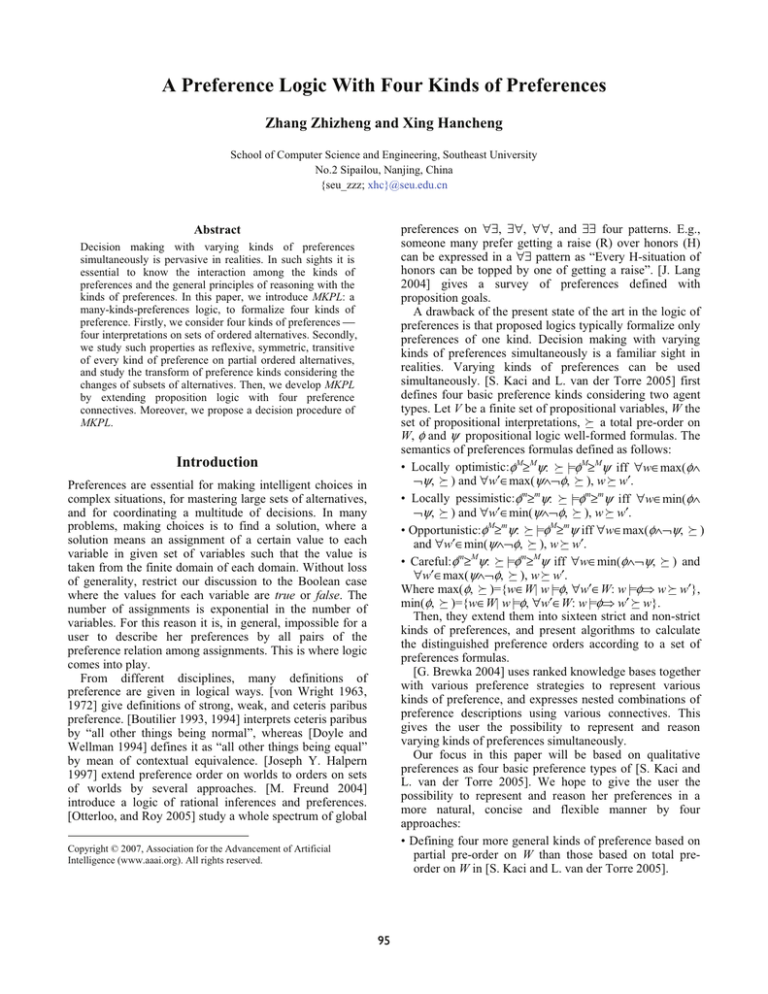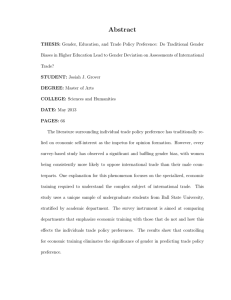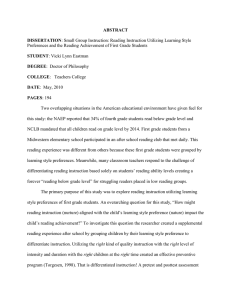
A Preference Logic With Four Kinds of Preferences
Zhang Zhizheng and Xing Hancheng
School of Computer Science and Engineering, Southeast University
No.2 Sipailou, Nanjing, China
{seu_zzz; xhc}@seu.edu.cn
preferences on ∀∃, ∃∀, ∀∀, and ∃∃ four patterns. E.g.,
someone many prefer getting a raise (R) over honors (H)
can be expressed in a ∀∃ pattern as “Every H-situation of
honors can be topped by one of getting a raise”. [J. Lang
2004] gives a survey of preferences defined with
proposition goals.
A drawback of the present state of the art in the logic of
preferences is that proposed logics typically formalize only
preferences of one kind. Decision making with varying
kinds of preferences simultaneously is a familiar sight in
realities. Varying kinds of preferences can be used
simultaneously. [S. Kaci and L. van der Torre 2005] first
defines four basic preference kinds considering two agent
types. Let V be a finite set of propositional variables, W the
set of propositional interpretations, V a total pre-order on
W, φ and ψ propositional logic well-formed formulas. The
semantics of preferences formulas defined as follows:
• Locally optimistic:φM≥Mψ: V |=φM≥Mψ iff ∀w∈max(φ∧
¬ψ, V ) and ∀w′∈max(ψ∧¬φ, V ), w V w′.
• Locally pessimistic:φm≥mψ: V |=φm≥mψ iff ∀w∈min(φ∧
¬ψ, V ) and ∀w′∈min(ψ∧¬φ, V ), w V w′.
• Opportunistic:φM≥mψ: V |=φM≥mψ iff ∀w∈max(φ∧¬ψ, V )
and ∀w′∈min(ψ∧¬φ, V ), w V w′.
• Careful:φm≥Mψ: V |=φm≥Mψ iff ∀w∈min(φ∧¬ψ, V ) and
∀w′∈max(ψ∧¬φ, V ), w V w′.
Where max(φ, V )={w∈W| w |=φ, ∀w′∈W: w |=φ w V w′},
min(φ, V )={w∈W| w |=φ, ∀w′∈W: w |=φ w′ V w}.
Then, they extend them into sixteen strict and non-strict
kinds of preferences, and present algorithms to calculate
the distinguished preference orders according to a set of
preferences formulas.
[G. Brewka 2004] uses ranked knowledge bases together
with various preference strategies to represent various
kinds of preference, and expresses nested combinations of
preference descriptions using various connectives. This
gives the user the possibility to represent and reason
varying kinds of preferences simultaneously.
Our focus in this paper will be based on qualitative
preferences as four basic preference types of [S. Kaci and
L. van der Torre 2005]. We hope to give the user the
possibility to represent and reason her preferences in a
more natural, concise and flexible manner by four
approaches:
• Defining four more general kinds of preference based on
partial pre-order on W than those based on total preorder on W in [S. Kaci and L. van der Torre 2005].
Abstract
Decision making with varying kinds of preferences
simultaneously is pervasive in realities. In such sights it is
essential to know the interaction among the kinds of
preferences and the general principles of reasoning with the
kinds of preferences. In this paper, we introduce MKPL: a
many-kinds-preferences logic, to formalize four kinds of
preference. Firstly, we consider four kinds of preferences ⎯
four interpretations on sets of ordered alternatives. Secondly,
we study such properties as reflexive, symmetric, transitive
of every kind of preference on partial ordered alternatives,
and study the transform of preference kinds considering the
changes of subsets of alternatives. Then, we develop MKPL
by extending proposition logic with four preference
connectives. Moreover, we propose a decision procedure of
MKPL.
Introduction
Preferences are essential for making intelligent choices in
complex situations, for mastering large sets of alternatives,
and for coordinating a multitude of decisions. In many
problems, making choices is to find a solution, where a
solution means an assignment of a certain value to each
variable in given set of variables such that the value is
taken from the finite domain of each domain. Without loss
of generality, restrict our discussion to the Boolean case
where the values for each variable are true or false. The
number of assignments is exponential in the number of
variables. For this reason it is, in general, impossible for a
user to describe her preferences by all pairs of the
preference relation among assignments. This is where logic
comes into play.
From different disciplines, many definitions of
preference are given in logical ways. [von Wright 1963,
1972] give definitions of strong, weak, and ceteris paribus
preference. [Boutilier 1993, 1994] interprets ceteris paribus
by “all other things being normal”, whereas [Doyle and
Wellman 1994] defines it as “all other things being equal”
by mean of contextual equivalence. [Joseph Y. Halpern
1997] extend preference order on worlds to orders on sets
of worlds by several approaches. [M. Freund 2004]
introduce a logic of rational inferences and preferences.
[Otterloo, and Roy 2005] study a whole spectrum of global
Copyright © 2007, Association for the Advancement of Artificial
Intelligence (www.aaai.org). All rights reserved.
95
• Ignoring von Wright’s expansion principle in the new
preference types. The principle means that a preference
of φ over ψ is interpreted as a preference of φ∧¬ψ over
ψ∧¬φ.
• Regarding preference connectives as general propositional connectives, like ∧,∨,¬ etc.
• Studying a whole proof system.
Firstly, we present four general preference types
considering four interpretations on sets of partial-ordered
alternatives. Secondly, we study such properties as
reflexive, symmetric, transitive of every kind of preference
on partial ordered alternatives, and study the transform of
preference kinds considering the changes of sets of
alternatives. Then, we develop MKPL by extending
proposition logic with four preference connectives.
Moreover, we propose a decision procedure with MKPL.
Properties of Order on Sets of Worlds
Proposition 1. Let Ω be a finite set of alternatives, R a
partial order on Ω, A and B subsets of Ω. We define the
following relations on sets of alternatives:
• R∃∀: AR∃∀B iff A≠∅ and B=∅, or ∃a∈A and ∀b∈B, aRb.
• R∀∃: AR∀∃B iff A≠∅ and B=∅, or ∀a∈A and ∃b∈B, aRb.
• R∃∃: AR∃∃B iff A≠∅ and B=∅, or ∃a∈A and ∃b∈B, aRb.
• R∀∀: AR∀∀B iff A≠∅ and B=∅, or ∀a∈A and ∀b∈B, aRb.
then
1) R∃∃ and R∀∃ are reflexive on 2Ω-∅.
2) R∃∀, R∀∃, and R∀∀ are transitive on 2Ω.
Proof. 1) R is reflexive, then ∀c∈Ω, cRc must hold. For
any A∈2Ω-∅, ∀a∈Aa∈Ω, aRa must hold, then AR∃∃A
and AR∀∃A.
2) R is transitive, then if ∀a, b, c∈Ω, aRb and bRc, aRc
must hold. Let A, B, C∈2Ω, then
• when AR∃∀B and BR∃∀C, if C=∅ AR∃∀C must be true,
else if ∃a∈A, ∀b∈B, aRb and ∃b∈A, ∀c∈B, bRc, then
aRc must be true, so AR∃∀C.
• when AR∀∃B and BR∀∃C, if C=∅ AR∀∃C must be true,
else if ∀a∈A and ∃b∈B, aRb and ∀b∈A and ∃c∈C, bRc,
then aRc must be true, so AR∀∃C.
• when AR∀∀B and BR∀∀C, if C=∅ AR∀∀C must be true,
else if ∀a∈A and ∀b∈B, aRb and ∀b∈A and ∀c∈C,
bRc, then aRc must be true, so AR∀∀C.
Four Kinds of Preferences
Let V be a finite set of propositional variables, W the set of
propositional interpretations, φ and ψ propositional logic
well-formed formulas. If V is a partial order on W, max(φ,
V ) and min(φ, V ) may be empty, and are inexplainable.
We present four more general preference types as follows:
• Locally optimistic:φ∃≥∀ψ: V |=φ∃≥∀ψ iff ∃w∈{w∈W| w
|=φ} and ∀w′∈{w∈W| w |=ψ}, w V w′.
• Locally pessimistic:φ∀≥∃ψ: V |=φ∀≥∃ψ iff ∀w∈{w∈W| w
|=φ} and ∃w′∈{w∈W| w |=ψ}, w V w′.
• Opportunistic:φ ∃≥∃ψ: V |=φ∃≥∃ψ iff ∃w∈{w∈W| w|=φ}
and ∃w′∈{w∈W| w |=ψ}, w V w′.
• Careful:φ∀≥∀ψ: V |=φ∀≥∀ψ iff ∀w∈{w∈W| w|=φ} and
∀w′∈{w∈W| w |=ψ}, w V w′.
Evidently, If V is a total pre-order on W, we can get
that (φ∧¬ψ)∃≥∀(ψ∧¬φ)⇔φM≥Mψ, (φ∧¬ψ)∀≥∃(ψ∧¬φ)⇔
φm≥mψ, (φ∧¬ψ)∃≥∃(ψ∧¬φ)⇔φM≥mψ, and (φ∧¬ψ)∀≥∀(ψ∧
¬φ)⇔φm≥Mψ.
Example 1. Let V={p, q}, p∧q V p∧¬q V ¬p∧q V ¬p∧¬q.
We can see that V |= p∀≥∀q, V |=¬q∀≥∀¬p, V |=¬p∃≥∃q etc.
Note that our preferences on ∀∃, ∃∀, ∀∀, and ∃∃ four
patterns are different from those of [Otterloo, and Roy
2005]. E.g., “someone prefers getting a raise (R) over
honors (H)” expressed in our ∀∃ pattern means “For each
R-situation of getting a raise, there exist some H-situations
of honor that are topped by it”.
Transform of Preference Kinds
As showed in fig.1, preference reasoning with four kinds
of preferences is to find complete preference relations Rxy
(x,y∈{∀, ∃}) on 2Ω that must be consistent with the known
part of Rxy. The part of Rxy on single element sets is just R.
Rx(unknown)
Model checking to find
the part of Rxy on Ω
based on the known part
R
Rxy (Known)
Theory proof to prove a
preference in Rxy based on
known part.
Fig.1. Preference Reasoning
We study preference reasoning in the following patterns:
(1) ⊆ patterns
• C⊆A, ARxyB CRx′y′B
• C⊆B, ARxyB ARx′y′C
• A⊆C, ARxyB CRx′y′B
• B⊆C, ARxyB ARx′y′C
(2) ŀ patterns
• (AŀC)RxyB CRx′y′B, ARx′y′B
• ARxy(BŀC) ARx′y′B, ARx′y′C
• ARxyB (AŀC)Rx′y′B, (AŀCc)Rx″y″B
• ARxyB ARx′y′(BŀC), ARx″y″(BŀCc)
(3) * patterns
• (A * C)RxyB C Rx′y′B, ARx″y″B
• ARxy(B * C) ARx′y′B, ARx″y″C
Properties and Transform
Above four kinds of preference mean four methods of
going from an ordering on worlds to one on sets of worlds.
With the uniform meaning, methods in [S. Kaci and L. van
der Torre 2005] can only go from a total pre-order on
worlds to one on sets of worlds, and our methods can go
from the more real-life partial order on worlds to one on
sets of worlds. A propositional formula φ represents a set
of worlds {w∈W| w |=φ}. We can study these preferences
from the set theory discipline.
96
• C⊆A then ∀c∈Cc∈A, and cRb. That is CR∀∃B.
• B⊆Cb∈C, then ∃c∈C, aRc. That is AR∀∃C.
• it must be b∈BŀC or b∈BŀCc, then ∃c∈BŀC or
∃c∈BŀCc, aRc. That is AR∀∃(BŀC), or AR∀∃(BŀCc).
The above principles give us a clear picture of four kinds
of preference from set theory discipline.
• ARxyB (A * C)Rx′y′B, (A * Cc)Rx″y″B
• ARxyB ARx′y′(B * C), ARx″y″ (B * Cc)
By predigesting iterative results, we conclude the
following proposition.
Proposition 2. Let Ω be a finite set of alternatives, R a
partial order on Ω, A, B and C nonempty subsets of Ω. It
can be concluded that
(1) for R∃∀
• AR∃∀B, A⊆CCR∃∀B
• AR∃∀B(AŀC)R∃∀B, or (AŀCc)R∃∀B
• AR∃∀B,B⊆CAR∃∃C
• AR∃∀B,C⊆BAR∃∀C
(2) for R∃∃
• AR∃∃B,A⊆CCR∃∃B
• AR∃∃B(AŀC)R∃∃B, or (AŀCc)R∃∃B
• AR∃∃B,B⊆C AR∃∃C
• AR∃∃B AR∃∃(BŀC), or AR∃∃(BŀCc)
(3) for R∀∀
• AR∀∀B,C⊆ACR∀∀B
• AR∀∀B,A⊆CCR∃∀B
• AR∀∀B,B⊆CAR∀∃C
• AR∀∀B,C⊆BAR∀∀C
(4) for R∀∃
• AR∀∃B,A⊆CCR∃∃B
• AR∀∃B,C⊆ACR∀∃B
• AR∀∃B,B⊆CAR∀∃C
• AR∀∃B AR∀∃(BŀC), or AR∀∃(BŀCc)
Proof. A, B, and C are nonempty.
(1) AR∃∀B⇔∃a∈A, ∀b∈B, aRb,
• A⊆Ca∈C, then ∃c∈C, cRb. That is CR∃∀B.
• it must be a∈AŀC or a∈AŀCc, then ∃c∈AŀC, ∀b∈B,
aRb or ∃c∈AŀCc, ∀b∈B, cRb. That is (AŀC)R∃∀B, or
(AŀCc)R∃∀B.
• B⊆Cb∈C, then ∃c∈C, aRc. That is AR∃∃C.
• if C⊆B, then ∀c∈Cc∈B, and aRc. That is AR∃∀C.
(2) AR∃∃B⇔∃a∈A, ∃b∈B, aRb,
• A⊆Ca∈C, then ∃c∈C, ∃b∈B, cRb. That is CR∃∃B.
• it must be a∈AŀC or a∈AŀCc, then ∃c∈AŀC, ∀b∈B,
aRb or ∃c∈AŀCc, ∀b∈B, cRb. That is (AŀC)R∃∀B, or
(AŀCc)R∃∀B.
• B⊆Cb∈C, then ∃a∈A, b∈C, aRb. That is AR∃∃C.
• it must be b∈BŀC or b∈BŀCc, then ∃a∈A, ∃c∈BŀC or
∃c∈BŀCc, aRc. That is AR∃∃(BŀC), or AR∃∃(BŀCc).
(3) AR∀∀B⇔∀a∈A, ∀b∈B, aRb,
• C⊆A then ∀c∈Cc∈A, and cRb. That is CR∀∀B.
• A⊆C a∈C, then ∃c∈C, cRb. That is CR∃∀B.
• B⊆Cb∈C, then ∃c∈C, aRc. That is AR∀∃C.
• C⊆B, then ∀c∈Cc∈B, and aRc. That is AR∀∀C.
(4) AR∀∃B⇔∀a∈A, ∃b∈B, aRb,
• A⊆C a∈C, then ∃c∈C, cRb. That is CR∃∃B.
MKPL Logic
We develop MKPL by extending proposition logic with
four preference connectives ∃≥∀, ∀≥∃, ∃≥∃, and ∀≥∀.
Definition 1 (Language). Given a set V={p1, …, pn} be a
finite set of propositional variables, we define the set LMKPL
of MKPL formulas as follows.
• pi∈LMKPL
•φ,ψ∈LMKPL¬φ∈LPL,φ→ψ∈LMKPL,φx≥yψ∈LMKPL, x,y∈{∀,
∃}
•↔, ∨, ∧, F ,⊥, (, ) are defined as usually, x≥y has the same
priority as that of ∨.
Definition 2 (Semantics). Given a preference model
M=(W, R), W the set of propositional interpretations 2V, R
a partial order on W, w∈W, we write w a set of variable,
p∈w iff p is true. The semantics of MKPL is defined as
follows.
• M, w|=p iff p∈w
• M, w|=¬φ iff M, w|≠φ
• M, w|=φ→ψ iff M, w|=¬φ, or M, w|=ψ
• M, w|=φ∀≥∀ψ iff M, w|=φ and ∀w′∈W(M, w′|≠ψ), or
∀w1∈W(M, w1|=φ) and ∀w2∈W(M, w2|=ψ), w1Rw2
• M, w|=φ∃≥∀ψ iff M, w|=φ and ∀w′∈W(M, w′|≠ψ), or
∃w1∈W(M, w1|=φ) and ∀w2∈W(M, w2|=ψ), w1Rw2
• M, w|=φ∃≥∃ψ iff M, w|=φ and ∀w′∈W(M, w′|≠ψ), or
∃w1∈W(M, w1|=φ) and ∃w2∈W(M, w2|=ψ), w1Rw2
• M, w|=φ∀≥∃ψ iff M, w|=φ and ∀w′∈W(M, w′|≠ψ), or
∀w1∈W(M, w1|=φ) and ∃w2∈W(M, w2|=ψ), w1Rw2
Lemma 1. Given a MKPL formulas φ, if ¡φ expresses that
φ is satisfiable, then ¡φ↔(φ∃≥∃φ). If ♦φ expresses that φ is
a tautology, then ♦φ↔¬(¬φ∃≥∃¬φ).
Proof. Let M=(W, R), w be a preference model,
(1) M, w|=¡φ iff ∃w′∈W, M, w′|=φ. M, w|=φ∃≥∃φ iff
∃w1∈W(M, w1|=φ) and ∃w2∈W(M, w2|=ψ), w1Rw2, that is
∃w′∈W, M, w′|=φ.
(2) ♦φ↔¬¡¬φ↔¬(¬φ∃≥∃¬φ).
Definition 3 (Maximal Propositional Conjunction). A
maximal propositional conjunction is an ordered
conjunction of atoms or negated atoms such that every
atom in V is mentioned exactly once.
According to a usual procedure of transforming a
propositional formula into complete normal propositional
disjunction, it is easy to decide whether φ can be expressed
by a maximal propositional conjunction. We write ♠φ if φ
can be expressed by a maximal propositional conjunction.
97
yw2∈W(M, w2|=ψ), w1Rw2, where x, y∈{∃,∀}. This
means that there exist(s) models of φ, that is M, w|=¡φ.
• Axiom 3: Suppose that M, w|=♠φ∧♠ψ. There is exactly
only one w″, M, w″|=φ, and There is exactly only one w′,
M, w′|=ψ. So M, w|=φx≥yψ⇔w″Rw′⇔M, w|=φx′≥y′ψ holds
for any x, y, x′, y′∈{∃,∀}.
• Axiom 4-7: Suppose that M, w |=¡ψ∧(((φ∀≥∃ψ)∧γ)∃≥∀χ).
then
1) ∃w′∈W, M, w′|=ψ and M, w|=((φ∀≥∃ψ)∧γ), ∀w′∈W, M,
w′|≠χ, or
2) ∃w′∈W, M, w′|=ψ, ∃w1∈W(M, w1|=((φ∀≥∃ψ)∧γ)) and
∀w2∈W(M, w2|=γ), w1Rw2.
If 1) holds, then M, w|=¡ψ. M, w|=((φ∀≥∃ψ)∧γ)M,
w|=φ∀≥∃ψ and M, w|=γ. M, w|=γ and ∀w′∈W, M,
w′|≠χM, w|=γ ∃≥∀χ. These three conclusions can be
combined to derive M, w|=¡ψ∧(φ∀≥∃ψ)∧(γ ∃≥∀χ).
If 2) holds, then M, w |=¡ψ. M, w1|=φ∀≥∃ψ, M, w1|=γ. M,
w|=¡ψ and M, w1|=φ∀≥∃ψ∀w0∈W(M, w0|=φ), ∃w2∈W
(M, w2|=ψ), w0Rw2 M, w|=φ∀≥∃ψ. M, w1|=γ, ∀w2∈W(M,
w2|=γ), w1Rw2 M, w|=γ ∃≥∀χ. These three conclusions
can be combined to derive M, w|=¡ψ∧(φ∀≥∃ψ)∧(γ ∃≥∀χ).
The above proof procedure is reversible, so we can get
that ¡ψ∧(((φ∀≥∃ψ)∧γ)∃≥∀χ)↔¡ψ∧(φ∀≥∃ψ)∧(γ ∃≥∀χ).
For other interpretations of x, y, x′, y′, and axiom 5-7, the
proof are of the same type.
• Axiom 8:
these axioms can be easily derived from the
corresponding conclusions in proposition 1.
• Axiom 9: these axioms can be easily derived from the
corresponding conclusions in proposition 2.
(2) Completeness. SMKPL is complete iff |=φ implies
SMKPL|−φ. Let S be a maximally consistent set containing φ.
All we need to do is to show that there is a model M, w
such that ∀ψ∈S: M, w|=¡ψ. In SMKPL, all axioms are based
on a partial order, we need to construct M=(W, R) with R a
partial order.
Let SP={α x≥yβ| both α and β are maximal propositional
conjunction, x, y∈{∃,∀}}, then construct M=(W, R) with
W=2V and R={(α , β)|α x≥yβ∈SP}. According to axiom 3,
R={(α, β)|α∀≥∀β∈SP}={(α, β)|α∀≥∃β∈SP}={(α, β)|α∃≥∃β
∈SP}={(α, β)|α∃≥∀β∈SP}. According to axiom 8, 9, R is
reflexive and transitive: a partial order.
Evidently, no matter what R is, there is exactly only w∈W,
we have M, w|=φ. Therefore, we can treat a maximal
propositional conjunction as a world of 2V in the following.
Definition 4 (Proof System SMKPL).
Axiom
1. all propositional tautologies
2. φ x≥yψ→¡φ
3. ♠φ∧♠ψ→((φx≥yψ)↔(φ x′≥y′ψ))
4. ¡ψ∧(((φ x≥yψ)∧γ) x′≥y′χ)↔¡ψ∧(φ x≥yψ)∧(γ x′≥y′χ)
5. ¡ψ∧((¬(φ x≥yψ)∧γ) x′≥y′χ)↔¡ψ∧¬(φ x≥yψ)∧(γ x′≥y′χ)
6. ¡ψ∧(χ x′≥y′((φx≥yψ)∧γ))↔¡ψ∧(φ x≥yψ)∧(χ x′≥y′γ)
7. ¡ψ∧(χ x′≥y′(¬(φ x≥yψ)∧γ))↔¡ψ∧¬(φ x≥y ψ)∧(χ x′≥y′γ)
8. Order axiom:
• R∃∃: ¡φ→φ∃≥∃φ
• R∀∃: ¡φ→φ∀≥∃φ
• T∀∀: (φ ∀≥∀ψ)∧(ψ ∀≥∀γ)→φ ∀≥∀γ
• T∀∃: (φ∀≥∃ψ)∧(ψ ∀≥∃γ)→φ ∀≥∃γ
• T∃∀: (φ ∃≥∀ψ)∧(ψ∃≥∀γ)→φ∃≥∀γ
9. Transform axiom:
•∃∀R1: (¡φ∧¡ψ∧¡γ)∧♦(φ→γ)∧(φ∃≥∀ψ)→γ∃≥∀ψ
•∃∀R2: (¡φ∧¡ψ∧¡γ)∧(φ∃≥∀ψ)→((φ∧γ)∃≥∀ψ)∨((φ∧¬γ)∃
≥∀ψ)
•∃∀R3: (¡φ∧¡ψ∧¡γ)∧ (φ∃≥∀ψ)∧♦(ψ→γ)→φ∃≥∃γ
•∃∀R4: (¡φ∧¡ψ∧¡γ)∧ (φ∃≥∀ψ)∧♦(γ→ψ)→φ∃≥∀γ
•∃∃R1: (¡φ∧¡ψ∧¡γ)∧♦(φ→γ)∧(φ∃≥∃ψ)→γ∃≥∃ψ
•∃∃R2: (¡φ∧¡ψ∧¡γ)∧φ∃≥∃ψ→((φ∧γ)∃≥∃ψ)∨((φ∧¬γ)∃≥∃
ψ)
•∃∃R3: (¡φ∧¡ψ∧¡γ)∧(φ∃≥∃ψ)∧♦(ψ→γ)→φ∃≥∃γ
•∃∃R4: (¡φ∧¡ψ∧¡γ)∧φ∃≥∃ψ→(φ∃≥∃(ψ∧γ))∨(φ∃≥∃(ψ∧¬
γ))
•∀∀R1: (¡φ∧¡ψ∧¡γ)∧♦(γ→φ)∧(φ∀≥∀ψ)→γ∀≥∀ψ
•∀∀R2: (¡φ∧¡ψ∧¡γ)∧♦(φ→γ)∧(φ∀≥∀ψ)→γ∀≥∀ψ
•∀∀R3: (¡φ∧¡ψ∧¡γ)∧(φ∀≥∀ψ)∧♦(ψ→γ)→φ∀≥∃γ
•∀∀R4: (¡φ∧¡ψ∧¡γ)∧(φ∀≥∀ψ)∧♦(γ→ψ)→φ∀≥∀γ
•∀∃R1: (¡φ∧¡ψ∧¡γ)∧♦(φ→γ)∧(φ∀≥∃ψ)→γ∃≥∃ψ
•∀∃R2: (¡φ∧¡ψ∧¡γ)∧♦(γ→φ)∧(φ∀≥∃ψ)→γ∀≥∃ψ
•∀∃R3: (¡φ∧¡ψ∧¡γ)∧ (φ∀≥∃ψ)∧♦(ψ→γ)→φ∀≥∃γ
•∀∃R4: (¡φ∧¡ψ∧¡γ)∧φ∀≥∃ψ→(φ)∀≥∃(ψ∧γ))∨(φ∀≥∃(ψ∧
¬γ))
10. Modus Ponens: φ, φ→ψψ
Where x, y, x′, y′∈{∃,∀}, Order axiom and Transform
axiom are rewrite of proposition 1 and proposition 2 in
LMKPL.
Proposition 3. SMKPL is sound and complete.
Proof. (1) Soundness. The validity proofs for each axiom
are given below.
• Axiom 2: Suppose that M, w|=φ x≥yψ. We have that M,
w|=φ and ∀w′∈W, M, w′|≠ψ, or xw1∈W(M, w1|=φ) and
A Decision Procedure
In this section, we propose a decision procedure for SAT
of MKPL, that is, a procedure to decide whether there is a
preference model for a given formula φ of MKPL.
Definition 5 (Preference Formula). A MKPL formula φ is
a preference formula iff it has the form αx≥yβ. αx≥yβ is a
basic preference formula iff both α and β are
propositional formulas. αx≥yβ is a normal preference
formula iff both α and β are maximal propositional
conjunction.
Lemma 2. Conjunction expansion principles.
98
• (1) ¡(φ∧γ)∧¡(φ∧¬γ)∧(φ∀≥∀ψ)→((φ∧γ)∀≥∀ψ)∧((φ∧¬γ)
∀ ∀
≥ ψ)
• (2) φ∀≥∀ψ→(φ∀≥∀(ψ∧γ))∧(φ∀≥∀(ψ∧¬γ))
• (3) φ∃≥∀ψ→((φ∧γ)∃≥∀ψ)∨((φ∧¬γ) ∃≥∀ψ)
• (4)φ∃ ≥∀ψ→(φ∃≥∀(ψ∧γ))∧(φ∃≥∀(ψ∧¬γ))
• (5) ¡(φ∧γ)∧¡(φ∧¬γ)∧(φ∀≥∃ψ)→((φ∧γ)∀≥∃ψ)∧((φ∧¬γ)
∀ ∃
≥ ψ)
• (6) φ∀≥∃ψ→(φ∀≥∃(ψ∧γ))∨(φ∀≥∃(ψ∧¬γ))
• (7) φ∃≥∃ψ→((φ∧γ)∃≥∃ψ)∨((φ∧¬γ)∃≥∃ψ)
• (8) φ∃≥∃ψ→(φ∃≥∃(ψ∧γ))∨(φ∃≥∃(ψ∧¬γ))
Proof.(1) can be derived from axiom 2 and ∀∀R1, (2) can
be derived from axiom 2 and ∀∀R4, (3) can be derived
from axiom 2 and ∃∀R1, (4) can be derived from axiom 2
and ∃∀R4, (5) can be derived from axiom 2 and ∀∃R2, (6)
can be derived from axiom 2 and ∀∃R4, (7) can be derived
from axiom 2 and ∃∃R2, (8) can be derived from axiom 2
and ∃∃R4.
Lemma 3. Disjunction expansion principles.
•(1) ((φ∨γ)∀≥∀ψ)∧¡φ∧¡γ→(φ∀≥∀ψ)∧(γ∀≥∀ψ)
•(2) φ∀≥∀(ψ∨γ)→(φ∀≥∀ψ)∧(φ∀≥∀γ)
•(3) (φ∨γ)∃≥∀ψ→(φ∃≥∀ψ)∨(γ∃≥∀ψ)
•(4) φ∃≥∀(ψ∨γ)→(φ∃≥∀ψ)∧(φ∃≥∀γ)
•(5) (φ∨γ)∀≥∃ψ∧¡φ∧¡γ→(φ∀≥∃ψ)∧(γ∀≥∃ψ)
•(6) φ∀≥∃(ψ∨γ)→(φ∀≥∃ψ)∨(φ∀≥∃γ)
•(7) (φ∨γ)∃≥∃ψ→(φ∃≥∃ψ)∨(γ∃≥∃ψ)
•(8) φ∃≥∃(ψ∨γ)→(φ∃≥∃ψ)∨(φ∃≥∃γ)
Proof. (1) can be derived from axiom 2 and ∀∀R1, (2) can
be derived from axiom 2 and ∀∀R4, (3) can be derived
from axiom 2 and ∃∀R1, (4) can be derived from axiom 2
and ∃∀R4, (5) can be derived from axiom 2 and ∀∃R2, (6)
can be derived from axiom 2 and ∀∃R4, (7) can be derived
from axiom 2 and ∃∃R2, (8) can be derived from axiom 2
and ∃∃R4.
Our decision procedure is inspired by von Wright’s
decision procedure in his preference logic, and similarly
includes two steps: normalization and consistency
checking. The normalization step to transform a wellformed formula into its normal form is based on axioms 47, conjunction expansion principles, and disjunction
expansion principles. In the normal form, all preference
formulas are normal preference formulas. The consistency
checking step is based on axiom 8, axiom 9, and truth
tables. Following the normalization step, one assigns truthvalues to these normal preference formulas and computes
the resulting truth-tables. We describe the procedure using
an example as follows.
Example 2. Let V={p, q}, φ≡p∧q∧(((p∀≥∀¬p)∧q)∃≥∀(¬q∨
p)). Check the satisfiability of φ as follows:
1. Normalization
(1)Decompose preference formulas of φ into basic
preference formulas by axiom 4. Transform φ into φ1.
φ1≡ p∧q∧(p∀≥∀¬p)∧(q∃≥∀(¬q∨p))
(2)Remove disjunction in preference formulas based on
disjunction expansion principles (4), and transform φ1
into φ2.
φ2≡ p∧q∧(p∀≥∀¬p)∧(q∃≥∀¬q)∧(q∃≥∀p)
(3) Suppose p∈V, but does not occur in β or α of a basic
preference formula αx≥yβ. According to conjunction
expansion principles, transform basic preference
formulas into normal preference formulas. For φ2:
•Use conjunction expansion principles (1) and (2) on
p∀≥∀¬p, we get:
((p∧q)∀≥∀(¬p∧q))∧((p∧q)∀≥∀(¬p∧¬q))∧((p∧¬q)∀≥∀(¬
p∧q))∧ ((p∧¬q)∀≥∀(¬p∧¬q))
• Use conjunction expansion principles (3) and (4) on
q∃≥∀¬q, we get: (((p∧q)∃≥∀(p∧¬q))∧((p∧q)∃≥∀(¬p
∧¬q)))∨(((¬p∧q)∃≥∀(p∧¬q))∧ ((¬p∧q)∃≥∀(¬p∧¬q)))
• Use conjunction expansion principles (3) and (4) on
q∃≥∀p, we get: (((p∧q)∃≥∀(p∧¬q))∧((p∧q)∃≥∀(p∧q)))∨
(((¬p∧q)∃≥∀(p∧¬q))∧ ((¬p∧q)∃≥∀(p∧q)))
Combine these results, transform φ2 into φ3
φ3≡ p∧q∧((p∧q)∀≥∀(¬p∧q))∧((p∧q)∀≥∀(¬p∧¬q))∧((p∧¬q)
∀ ∀
≥ (¬p∧q))∧((p∧¬q)∀≥∀(¬p∧¬q))∧((((p∧q)∃≥∀(p∧¬q))
∧((p∧q)∃≥∀(¬p∧¬q)))∨(((¬p∧q)∃≥∀(p∧¬q))∧((¬p∧q)∃≥
∀
(¬p∧¬q))))∧((((p∧q)∃≥∀(p∧¬q))∧((p∧q)∃≥∀(p∧q)))∨(((
¬p∧q)∃≥∀(p∧ ¬q)) ∧((¬p∧q)∃≥∀(p∧q))))
2. Consistency checking
Assign truth-values to the normal preference formulas
and computes the resulting truth-tables in the following
way:
•The constituent of the form αx≥yβ is assigned true.
•If both αx≥yβ and βx′≥y′γ are assigned true, the
constituent αx″≥y″γ is also assigned true.
•Finally, ones compute the truth-table in a standard way.
Check φ3, we can get M=({p∧q, p∧¬q, ¬p∧q, ¬p∧¬q}, R),
w= p∧q is a model of φ3, where R is as showed in Fig.2.
p∧q
p∧¬q
¬p∧q
¬p∧¬q
Fig.2. R
Conclusion
In this paper, we introduce MKPL: a many-kindspreferences logic with finite set of propositional variables,
to formalize four kinds of preference. We hope to give the
user(s) the possibility to represent and reason her(their)
varying kinds of preferences simultaneously in a more
natural, concise and flexible manner by four approaches:
(1)Defining four more general kinds of preference based
on partial order on W than those based on total pre-order
99
on W in [S. Kaci and L. van der Torre 2005]. (2) Ignoring
von Wright’s expansion principle in the new preference
types. (3)Regarding preference connectives as general
propositional connectives, like ∧,∨,¬ etc. (4) Studying a
whole proof system. Moreover, we propose a decision
procedure with MKPL.
We are currently extending the work in this paper in the
following directions.
• We are investigating expressive power of MKPL for
preference representation by comparing with other
preference definitions.
• We plan to add ceteris paribus constraint in MKPL, and
plan to investigate computational issue related the
approach. In particular, it would be interesting to see the
application of varying kinds of preferences in logic
programming.
• We are trying to contain more combination strategies in
MKPL, and to find general principles of reasoning with
varying kinds of preferences simultaneously.
G. Brewka 2004. A Rank Based Description Language for
Qualitative Preferences. In Proceedings of the 16th
European Conf. on Artificial Intelligence. Valencia: IOS
Press, 303-307.
J. Doyle 2004. Prospects for Preferences. Computational
Intelligence, 20(2),111-136.
M. Öztürk, A. Tsoukiàs 2005, Vincke Ph. Preference
Modelling. In State of the Art in Multiple Criteria Decision
Analysis, Springer-Verlag, Berlin. 27-72.
References
G. H. von Wright 1963. The Logic of Preference.
Edinburgh.
G. H. von Wright 1972. The Logic of Preference
Reconsidered. Theory and Decision, 3:140-169.
C. Boutilier 1993. A Modal Characterization of Defeasible
Deontic Conditionals and Conditional Goals. AAAI Spring
Symposium on Reasoning about Mental States. 30-39.
C. Boutilier 1994. Toward a logic for Qualitative Decision
Theory. In Proceedings of the Fourth International
Conference on Principle of Knowledge Representation and
Reasoning, 75-86.
J. Doyle and M. P. Wellman 1994. Representing
Preferences as Ceteris Paribus Comparatives. Working
Notes of The AAAI Symposium on Decision-Theoretic
Planning, 69-75.
Joseph Y. Halpern 1997. Defining Relative Likelihood in
Partially-ordered Preferential Structure. Journal of
Artificial Intelligence Research, 7,1-24.
Michael Freund 2004. On the Revision of Preferences and
Rational Inference Process. Artificial Intelligence. 152,
105-137.
S. v. Otterloo and O. Roy 2005. Preference logic and
applications.
J. Lang 2004. Logic preference representation and
combinatorial vote. Annals of Mathematics and Artificial
Intelligence, 42,37–71.
S. Kaci and L. van der Torre 2005. Algorithms for a
Nonmonotonic Logic of Preferences. In Proceeding of 8th
European Conference on Symbolic and Quantitative
Approaches to Reasoning with Uncertainty. 281-292.
S. Kaci and L. van der Torre 2005. Non-monotonic
Reasoning with Various Kinds of Preferences. In
Proceedings of Multidisciplinary IJCAI-05 Workshop on
Advances in Preference Handling. 112-117.
100





